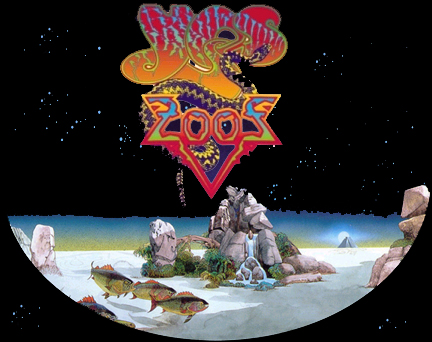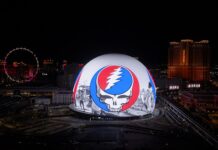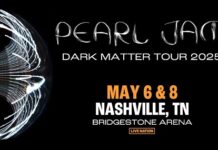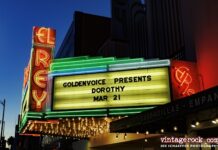Review by Shawn Perry
So, here’s my dilemma: I think Yes might be one of the most resilient bands in history. And I’ll tell you why. For one, they keep changing things enough to make it, well, interesting. Let me explain:
When guitarist Peter Banks was out, Steve Howe came in and raised the bar. When keyboardist Tony Kaye was out, Rick Wakeman came in and raised it even higher. When drummer Bill Bruford was out, that really sucked for Yes fans, but was a decidedly delicious time for King Crimson fans. But his replacement, Alan White, who had banged it up with no less than John Lennon and Eric Clapton, amazed everyone with his dexterous percussion skills. Along with co-founders Jon Anderson and Chris Squire, this was the combination that quaintly became known as Classic Yes.
Don’t be fooled by the word Classic. Other combinations of Yes have always been up to the task. When Wakeman left after the Tales Of Topographic Oceans debacle, the remaining members kept their chin up and hired Patrick Moraz to play on Relayer. From this came, “Gates Of Delirium” one of Yes’ most revered epics. Then Wakeman came back and Going For The One became a triumphant return to form without the excess. Would it last? After the disappointing Tormato album, both Wakeman AND Anderson bowed out, leaving the remaining three to not only carry on, but to replace its inimitable voice.
Drama introduced the world to Trevor Horn and Geoffrey Downes, becoming famous in their own right as the Buggles, whose “Video Killed The Radio Star” has the distinction of being the very first music video ever played on MTV (and they certainly don’t play ’em like they used to). Although Horn gave the group a slightly new wave vibe, even diehard Yes fans have a hard time dissing “Tempus Fugit.” It would be the last thing heard from the Yes camp for over two years.
So what happens next? Lots of stuff. Anderson goes solo. Howe and Downes form Asia with John Wetton and Carl Palmer. Squire and White supposedly nurture a short-lived liaison with Jimmy Page and Robert Plant with plans to call the band XYZ (translation: ex-Yes, Zeppelin). Needless to say, no such dream team was bound to last. So, Squire meets up with a guitarist from South Africa named Trevor Rabin. With White and original Yes keyboardist Kaye on board, Anderson is invited to sing on some of Rabin’s songs. Seizing the opportunity, the band unabashedly call themselves Yes and make a bold run at living up to the name. Still, with the coiffed hair and space age apparel, some were heard to call this new version of the band Diet Yes.
I’m still trying to figure out how Yes became such a big hit in the 80s. It’s not like they went totally commercial like Genesis, but something was afoul. Even if the music sounded poppier, the odd time signatures and overall musicality were still intact. After 90125 and its weaker follow-up Big Generator, Anderson, who is ceremoniously known as the band’s guiding light and new age spiritualist, is suddenly drawn to a familiar partnership. He reunites with Howe, Wakeman and Bruford and together they record an album, brazenly inserting each man’s last name in its title. Then they tour, playing mostly Yes songs from the 70s. Squire — the only one who has played on every Yes album and is rumored to own the name — sits on the sidelines along with White, Kaye and Rabin, waiting for a chance to get back in the game. Or so it seems when Union comes along.
Union is, up to this point in the band’s history, the most ambitious project ever undertaken by Yes. Musically, it pretty much misses its mark. But the tour that follows is a raging success — by sheer logistics alone. For those who may have forgotten, this is when the eight principal members come together on stage: Howe and Rabin on guitars, Wakeman and Kaye on keyboards, White and Bruford on drums, Squire on bass, and Anderson standing in the center of the in-the-round stage, more or less directing traffic and evidently loving every minute of it. The Japanese laser disc of the final Union show at Shoreline in Mountain View finds the entire crew in jovial spirits.
After that, things kinda get weird. The 80s line-up reunites and releases Talk, which barely scratches the upper reaches of the charts. After an uneventful tour, Rabin heads for the hills to write and produce soundtracks. Nothing really develops from there until, out of nowhere, Howe and Wakeman rejoin Squire, Anderson and White for a series of shows in San Luis Obispo, a college town south of San Jose, CA. The resulting KEYS TO ASCENSION discs are full of Yes classics from the 70s, played in a somewhat restrained manner, and a couple of new ones to boot. Then again, another change. For what’s been cited as nothing more than scheduling conflicts, Wakeman leaves the band for the third or fourth time (to be honest, I’m not keeping score). Unaffected (and possibly accustomed to defected personnel), the remaining four push forward and hire young guns Billy Sherwood and Igor Koroshev to round out their sound.
Throughout the late 90s, Yes hover on the edge of validity, releasing both Open Your Eyes and The Ladder to lukewarm receptions. Unfortunately, their brand of harmony-laced progressive rock is somewhat of a private reserve without a whole lotta fuss. You either get it or you don’t. As Yes continually tour through the new millennium, they rely even more on the music from their Classic period. Once Sherwood, and then Koroshev are let go, Anderson, Squire, Howe and White decide to carry on as a four piece. They look into alternatives for a keyboard player. Somewhere along the lines, someone says, ‘How about an orchestra?’
For the first time since Time And A Word, Yes record and tour with a full orchestra. Magnification is a scattered affair, but its strengths far out weight its weaknesses. The ensuing tour brings out the best in the band as they coast with rich accompaniment through some of the most gorgeous passages ever written. They bring along a keyboard player to augment the rough spots, but it’s clear from the DVD taken from the tour, SYMPHONIC LIVE, that Yes have once again taken their music to another level. All that’s missing is one vital piece of the puzzle.
Which brings me to my original point — that being, the resiliency of Yes. Well, it just so happens that the missing piece has been found, or rather returned. Rick Wakeman is once again, for the fifth time, a member of Yes. And if the performance at the Universal Amphitheatre is any indication of a bright and rosy future, I can hardly wait till next year.
This year, however, Yes is sticking with a proven formula — hardly breaking new ground, save for the wisps of MAGNIFICATION that creep into their set. But when the music is so forward thinking to begin with, is it such a crime to keep playing it? The proggy naysayers may speculate why the band is Yesterday’s news, but I’m still waiting to see what they have to offer as an alternative. I mean, today’s progressive rock is hardly taking it any further, is it? If you think the likes of Dream Theater are going to equal the output and sheer will of bands like Yes, King Crimson, Genesis or Jethro Tull, it’s time to have your ears surgically silenced.
You bet your sweet bippy they opened with “Siberian Khatru.” And while a large portion of the crowd was reeling from the mere sight of these same five individuals who had graced the silver screen in Yessongs, the young and alertless scratched their head in confusion as to why they went into Paul Simon’s “America.” Of course, seasoned Yes fans are well aware that along with this Simon and Garfunkel gem that appeared on a 1975 Yes compilation called YESTERDAYS, the band had also reworked the Byrds’ “I See You” and the Beatles’ “Every Little Things.” Clearly, the influences are far and wide as Anderson and Squire initially set out to build on the vocal harmonies while, in short order, the instrumental-cum-progressive leanings neatly fell in line.
Picking up from last year’s tour with the symphony, the group dished out a sampling of MAGNIFICATION. Unfortunately, a crowd thirsting for the classic brand barely responded to “In The Presence Of,” which, on its own, is hardly on par with some other newer tracks such as “Give Love Each Day.” Nevertheless, this low point in the proceedings was quickly salvaged with what came next. Perhaps to commemorate the return of Wakeman, the band reached down deep into their songbook and pulled out a rare plum from FRAGILE: “We Have Heaven/South Side Of The Sky.” The consensus is pretty much sealed on this one — a vocally enhanced menagerie that simply needs to become a permanent part of the set list. And did Wakeman wince once when the band then fell into “the Revealing Science Of God,” the opening number from the bloated Tales Of Topographic Oceans affair? Put into its proper perspective, the ill-fated concept piece is an essential stepping stone and a clear indication that even Yes, a full fledge progressive rock monster of the 70s, had to come up with a pretentious double record in the midst of a heady period when such things were practically expected.
The obligatory solo spots that greased both sides of the 20-minute intermission received a mixture of aplomb, boredom and exhilaration. Well, you know, it’s always a treat to see Professor Howe pour over his axe, and watching Wakeman’s fingers delicately fly over the ivories is a venerated moment, no matter what the context. Of course, teasing the audience with slices of “Wondrous Stories,” “And You And I” and “Heart Of the Sunrise” isn’t going to earn him any brownie points, but I’m sure he was outvoted when it came to song selection. Anderson’s turn with “Show Me” did little to kick-start the restless front rows. However, once the spotlight zeroed in on Squire during an otherwise stirring rendition of “The Fish,” I couldn’t escape to the bar fast enough for an $11 beer. Actually, after realizing I was financially depleted from covering the first round, I decided to brave it. As one of rock’s greatest bassist, Squire should avoid the solo sequence and stick to the sly accentuations he’s such a master at. Ever since he started topping the bass polls, he must feel it’s his God given right to prance and stalk the stage like an overbearing ogre, peeling off these big fat notes and basking in all the bemused adulation. Even the late and great John Entwistle, undeniably one of the few equally as dynamic as Squire, had the good sense to steer clear of the dreaded bass solo. Maybe Squire should chug down a fifth of JD like Van Halen’s Michael Anthony used to do during his bass solo. Now that would be great entertainment.
For what has become an expected finale, “Awaken” is still a feast for the eyes and ears. Over the years, Anderson has really developed into a capable multi-instrumentalist — adding percussional flourishes here and there, as well as occasionally playing keyboards and/or guitar. On “Awaken,” the simple, angelic notes Anderson discharges from his mini harp set the tone for Wakeman to open up and say ah! The build is slow, almost wanton in its quest, but momentous and fervent at the same time. As the song came to a crashing close some 20 minutes later, I felt compelled to rise from my seat and cheer with every ounce of appreciation I could summon. I could have left right then and there a satisfied fan.
Yes, of course, still had some unfinished business to attend to. Before they returned, I speculated on three possible encores: “Owner Of A Lonely Heart, “Seen All Good People,” or “Roundabout.” I’m thankful I was half right. It wouldn’t seem logical with Wakeman back in the fold that “Owner Of A Lonely Heart,” the band’s highest charting hit, would make an appearance. Quite frankly, I’m surprised they’ve played it in previous years since Howe rejoined. While “Seen All Good People” has been an FM staple forever, “Roundabout” is an ingrained signature no version of Yes can willingly dodge. But before things became too predictable, they stepped up and launched into “Yours Is No Disgrace,” a sloping journey of a tune that functioned as an early frontrunner of the unique Yes sound. For all of its enduring appeal, “Roundabout” was a shadowy footnote that signaled the end of a fairly spectacular evening of music.
As I exited across the narrow bridge and into the Times Square spectacle of Universal’s City Walk, I couldn’t help but wonder about the band’s next move. Even with everyone’s favorite members back on the team, could we truly expect something new and exciting over the horizon? Such is the synergy of Yes. Maybe that’s why people keep coming back.





















